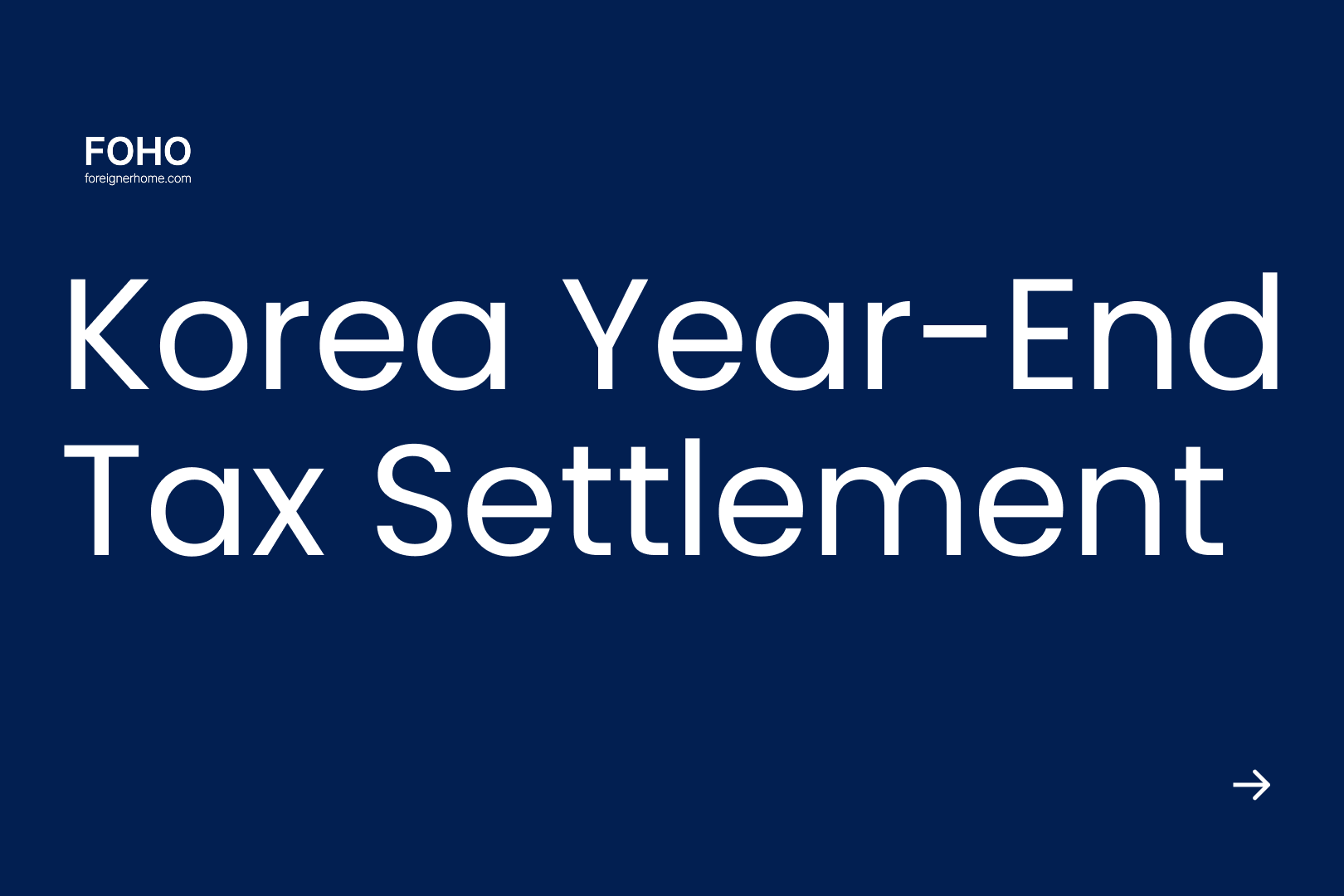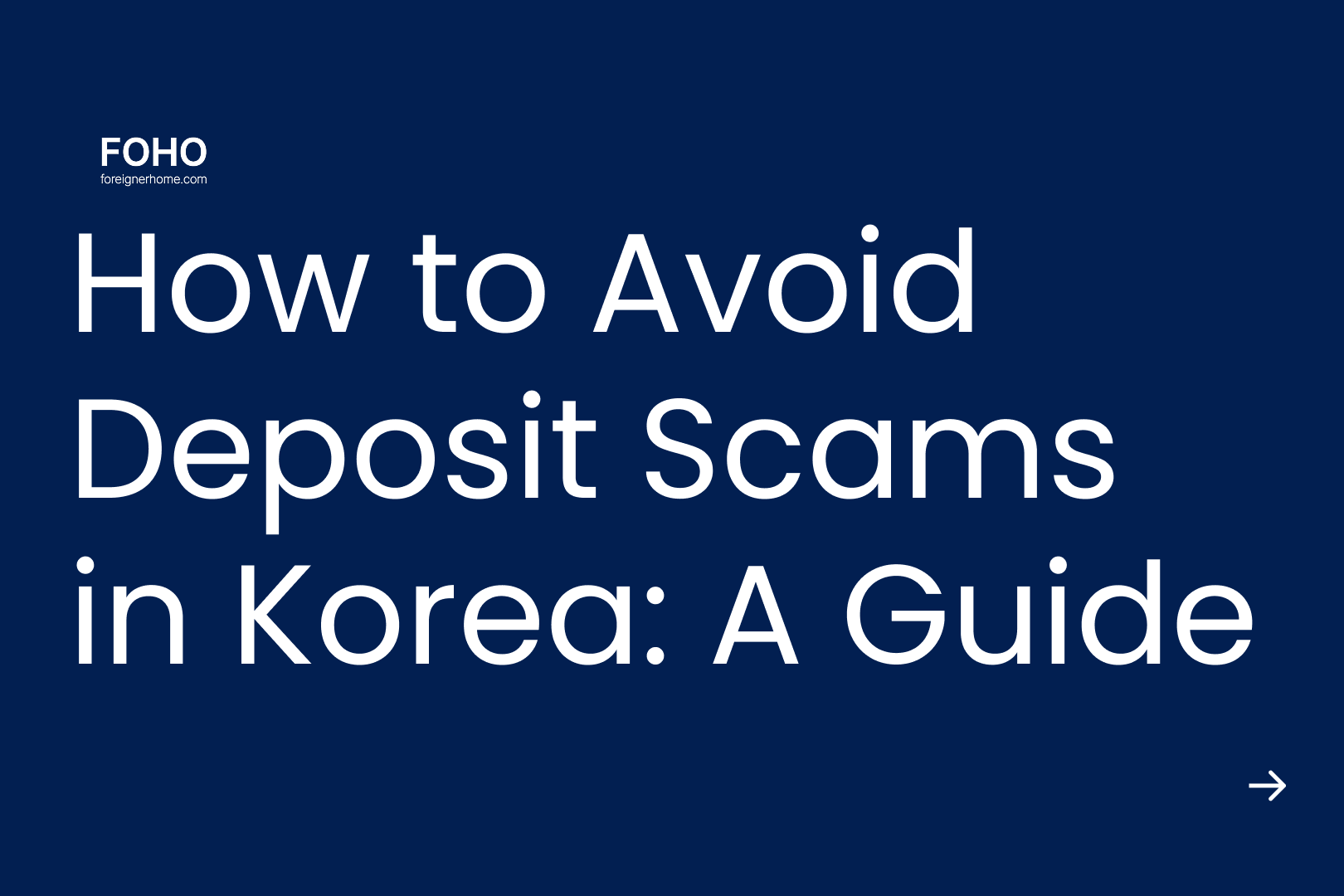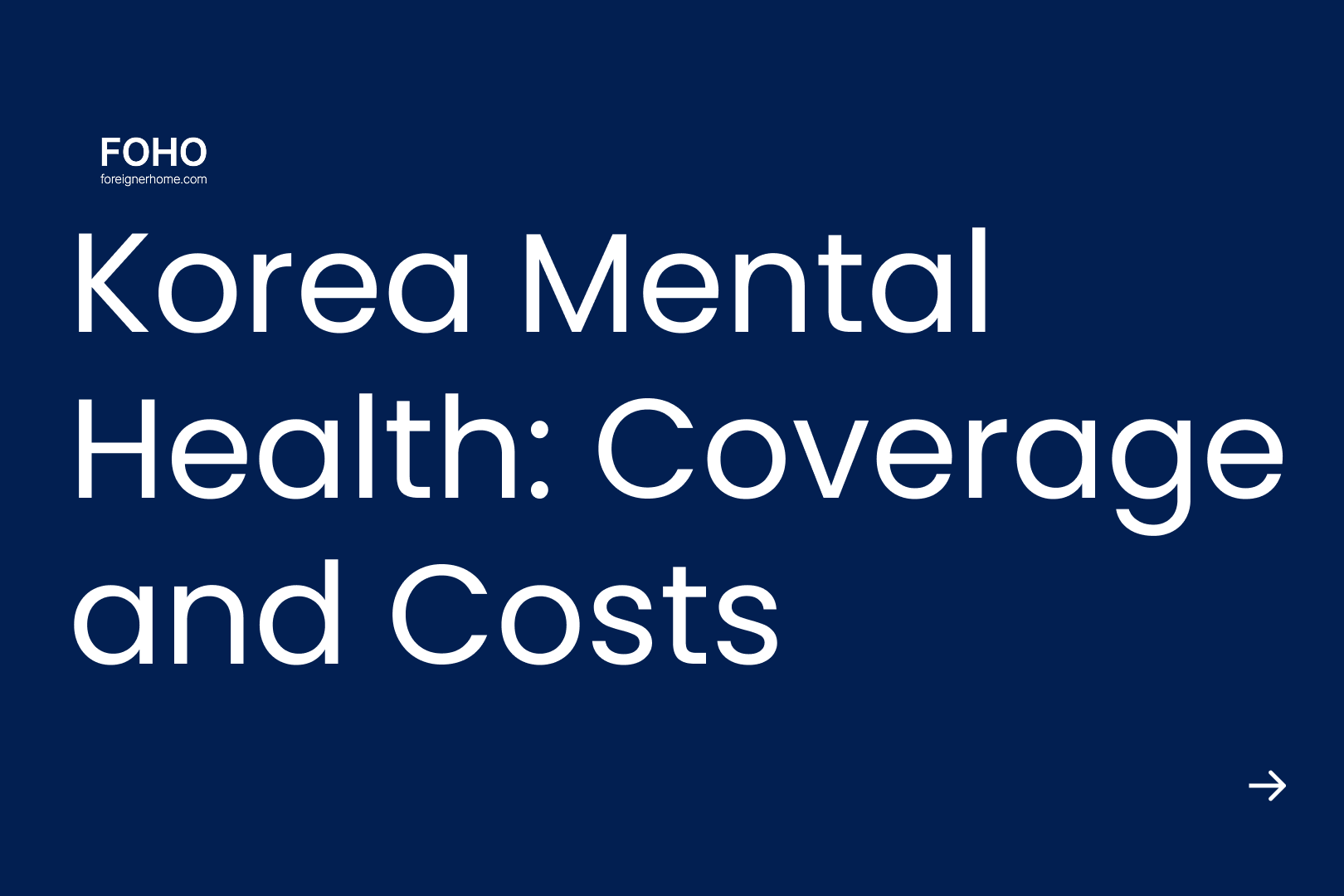FOHO Blog – Global Housing & Living Guide for Foreigners
Korea Year-End Tax Settlement: A Guide for Foreigners
Our complete guide to Korea's year-end tax settlement helps foreign residents navigate the process. Learn about deductions, residency, and Hometax to get your refund.

Table of contents
- 01Korea's Year-End Tax Settlement: A Complete Guide for Foreigners
- 02Part 1: Understanding the Basics
- •What Is Year-End Tax Settlement?
- •How Your Final Tax Is Calculated
- •Key Dates and Deadlines
- 03Part 2: The Most Important Factor: Your Residency Status
- •Are You a Resident or Non-Resident?
- •How Residency Affects Your Deductions
- 04Part 3: Strategic Tax Choices for Foreigners
- •Option 1: 19% Flat Tax Rate (단일세율 과세특례)
- •Option 2: Special Reductions for Engineers and Teachers
- 05Part 4: A Deep Dive on Deductions (For Residents)
- •Key Income Deductions
- •Key Tax Credits
- •Focus: The Monthly Rent (Wolse) Tax Credit
- 06Part 5: Claiming Dependents Living Abroad
- 07Part 6: Practical Steps and Resources
- •Step-by-Step Filing Guide
- •Common Mistakes to Avoid
- •Official Resources for Foreigners
- •Glossary of Key Terms
- 08Navigating Korea Is Easier with the Right Partner
- •Footnotes & Sources:
Korea's Year-End Tax Settlement: A Complete Guide for Foreigners
Part 1: Understanding the Basics
What Is Year-End Tax Settlement?
- If you overpaid: You receive a refund. This is why it's called the "13th-month salary."
- If you underpaid: You must pay the remaining balance.
How Your Final Tax Is Calculated
- Total Salary (총급여액): Your gross annual income, including salary and bonuses, minus non-taxable items like meal allowances.
- Earned Income Amount (근로소득금액): Your Total Salary minus the "earned income deduction," a standard deduction automatically applied based on your income level.
- Tax Base (과세표준): The Earned Income Amount minus various income deductions (e.g., personal allowances for yourself and dependents, pension contributions). This is the final income figure that will be taxed.
- Calculated Tax (산출세액): The Tax Base multiplied by Korea’s progressive income tax rates (6% to 45%).
- Determined Tax (결정세액): The Calculated Tax minus tax credits (e.g., for medical expenses, education, or rent). This is the actual, final amount of tax you owe for the year.
- Final Refund/Payment (차감징수세액): Your Determined Tax compared to the total tax already withheld from your salary.
Key Dates and Deadlines
Date Range | Activity |
Dec. 1 - Jan. 15 | Consent for the "Simplified Data Submission Service" on the Hometax website. This allows the National Tax Service (NTS) to send your deduction data directly to your employer. |
Jan. 15 | The NTS "Simplified Service" officially opens. You can now log in to Hometax and download your annual expenditure data. |
Mid-Jan. to Late Feb. | This is the main period to gather any documents not included in the Simplified Service (e.g., rent payment receipts, certain donation receipts) and submit everything to your company. |
By Feb. 28 | Your company must complete the year-end tax settlement process and report it to the tax office. |
Feb. to Apr. | Any tax refund is typically paid with your February or March salary. Additional taxes owed are deducted during this period. |
Part 2: The Most Important Factor: Your Residency Status
Are You a Resident or Non-Resident?
How Residency Affects Your Deductions
Deduction / Credit | Resident (거주자) | Non-Resident (비거주자) |
Basic Personal Allowance | Yes | Yes (Self only) |
Dependent Allowances | Yes | No |
Special Income Deductions | Yes | No |
Child Tax Credit | Yes | No |
Special Tax Credits (Medical, Education) | Yes | No |
Housing Fund Deductions | Yes | No |
Monthly Rent (Wolse) Tax Credit | Yes | No |
Part 3: Strategic Tax Choices for Foreigners
Option 1: 19% Flat Tax Rate (단일세율 과세특례)
- Eligibility: Applies for up to 20 consecutive years from the first day of working in Korea.
- The Trade-Off: If you choose the 19% flat rate, you cannot claim any other deductions or credits. This includes personal allowances, dependent allowances, medical costs, rent credits, and all non-taxable income benefits (like meal allowances).
- Who Benefits? This option is designed for high-income earners who have few eligible deductions. If your effective tax rate after all standard deductions is higher than 19%, the flat rate is likely the better choice.
Item | Case A: Progressive Tax Rate | Case B: 19% Flat Tax Rate | Notes |
Gross Annual Salary | ₩120,000,000 | ₩120,000,000 | |
Non-Taxable Income | - ₩5,000,000 | Included in tax base | Meal allowance, etc. |
Flat Tax Base | N/A | ₩120,000,000 | Entire gross salary |
Income Deductions | N/A | Forfeited with flat rate | |
- Earned Income | - ₩14,750,000 | N/A | Automatic deduction |
- Personal/Dependent | - ₩6,000,000 | N/A | Self, spouse, 2 children |
- Pension/Insurance | - ₩10,000,000 | N/A | |
Progressive Tax Base | ₩84,250,000 | N/A | Taxable income |
Calculated Tax | ₩15,127,500 | ₩22,800,000 | Progressive rate vs. 19% of ₩120M |
Tax Credits | N/A | Forfeited with flat rate | |
- Child Tax Credit | - ₩350,000 | N/A | |
- Medical/Education | - ₩1,000,000 | N/A | |
Determined Final Tax | ₩13,777,500 | ₩22,800,000 | |
Effective Tax Rate | ~11.5% | 19.0% | |
Conclusion | Progressive Tax Rate is better in this scenario. |
Option 2: Special Reductions for Engineers and Teachers
- Foreign Engineers: Engineers with specific qualifications working in designated high-tech sectors may be eligible for a 50% reduction in their income tax for up to 10 years. For those in core materials, parts, and equipment industries, the benefit is 70% for the first 3 years and 50% for the next 2. [7]
- Foreign Teachers/Professors: If your home country has a tax treaty with South Korea, you may be exempt from Korean income tax for your first two years of teaching at a government-approved institution (this typically excludes private language academies, or hagwons). Countries with this treaty include the U.S., U.K., Australia, and 71 others. [8]
Part 4: A Deep Dive on Deductions (For Residents)
- Income Deductions (소득공제): These reduce your taxable income. Their value depends on your tax bracket.
- Tax Credits (세액공제): These reduce your final tax bill directly. They are more powerful than income deductions because they provide a dollar-for-dollar reduction in the tax you owe.
Key Income Deductions
- Personal Allowance: A base deduction of ₩1.5 million for yourself and for each eligible dependent.
- National Pension & Health Insurance: The full amount you paid during the year is deductible.
- Credit/Debit Card & Cash Spending: This is a key area for strategic planning.
- The 25% Rule: You can only claim deductions on spending that exceeds 25% of your gross annual salary.
- The Two-Stage Strategy:
- Until you hit the 25% threshold, use a credit card that offers the best rewards or points, as this spending is not eligible for tax deductions anyway.
- After you cross the 25% threshold, switch to using a debit card or getting cash receipts (hyeon-geum-yeong-su-jeung), which have a 30% deduction rate—double the 15% rate for credit cards.
Key Tax Credits
- Insurance Premiums: Premiums for standard life and casualty insurance.
- Medical Expenses: Including glasses/contact lenses (up to ₩500,000 per person).
- Education Expenses: For yourself or your dependents.
- Donations: To specified organizations.
- Pension Savings: Contributions to private pension accounts are a powerful tool, offering a high tax credit rate on up to ₩9 million in annual contributions.
Focus: The Monthly Rent (Wolse) Tax Credit
- Requirements: Your total annual salary must be ₩70 million or less, and the rented property must be under the national housing size (85㎡) or meet a specific value standard. You must be the person named on the lease.
- Essential Documents: Unlike Korean citizens, foreigners cannot issue a
주민등록등본(Resident Registration Certificate). You must submit a외국인등록사실증명(Certificate of Alien Registration) instead. This can be obtained from a local community center or online via the Government24 portal. You also need a copy of your housing contract and proof of monthly rent payments (e.g., bank transfer records). [9]
Part 5: Claiming Dependents Living Abroad
- Proof of Relationship: An official document from your home country's government, such as a birth certificate, marriage certificate, or family register. This may need to be translated and notarized.
- Proof of Income: A document from your home country's tax authority or another official body proving the dependent's annual income is below the ₩1 million threshold.
- Proof of Support: Objective evidence that you are financially supporting them. The best proof is a record of regular, consistent bank transfers sent throughout the year. A single large transfer at the end of the year is less convincing.
Part 6: Practical Steps and Resources
Step-by-Step Filing Guide
- Secure a Digital ID: To access the Hometax system, you need a Korean digital certificate.
- Joint Certificate (공동인증서): The traditional digital certificate, available from your main bank.
- Simple Authentication (간편인증): A more modern method using private apps like Kakao, Naver, or your banking app. This is often easier for foreigners with a Korean phone and bank account.
- Use the Hometax "Simplified Service" (간소화 서비스): Log in to www.hometax.go.kr. The Simplified Service automatically gathers most of your expenditure data from credit card companies, hospitals, and banks. You can download this information as a single PDF file.
- Gather Additional Documents: Collect any receipts or proofs not covered by the service, such as your rent contract, overseas dependent documents, or certain donation receipts.
- Submit to Your Employer: Provide your company's HR or finance department with the Hometax PDF and all additional documents you collected. They will complete the final filing on your behalf.
Common Mistakes to Avoid
- Misjudging Residency Status: Incorrectly filing as a resident when you do not meet the criteria.
- Incorrectly Applying the Flat Tax Rate: Using the 19% flat rate when you have a special relationship with your employer (e.g., owning over 30% of the company).
- Insufficient Proof for Overseas Dependents: This is a leading cause for deduction denial.
- Forgetting Manual Submissions: Assuming the Simplified Service contains everything and forgetting to submit receipts for rent, eyeglasses, etc.
Official Resources for Foreigners
- NTS English Website: www.nts.go.kr/english/
- Easy Guide for Foreigners' Year-End Tax Settlement (PDF): Published annually.
- NTS English Consultation Line: 1588-0560
Glossary of Key Terms
- Yeonmal-jeongsan (연말정산): Year-end tax settlement.
- Woncheon-jingsu (원천징수): Withholding tax deducted from monthly salary.
- Sodeuk-gongje (소득공제): Income deduction; reduces taxable income.
- Sae-ek-gongje (세액공제): Tax credit; reduces the final tax bill directly.
- Hometax (홈택스): The official online portal of the National Tax Service.
Navigating Korea Is Easier with the Right Partner
Footnotes & Sources:
Settle in faster with FOHO
Browse more verified listings and message landlords in minutes. Lock in your lease with FOHO's secure payments.
Get Foreigner-Friendly Housing Tips
Get the latest news delivered to your inbox.

Nov 4, 2025
FOHO Launches Foreigner-Focused Rental Insurance
FOHO’s deposit insurance protects foreign tenants in Korea from landlord defaults. Stay safe with clear coverage and fast claims.

Oct 31, 2025
How to Convert E-9 Visa to E-7-4 in Korea
A guide for Vietnamese & Chinese E-9 workers in Korea. Learn the E-7-4 visa points system, F-2 requirements, and compare GME vs. Sentbe for remittance.

Oct 30, 2025
How to Avoid Deposit Scams in Korea: A Guide
Avoid deposit scams in Korea with our step-by-step guide. Learn to check property debt, understand the 'Deung-gibu,' and secure your deposit.

Oct 29, 2025
Korea Mental Health: NHIS Coverage and Costs
Get help with mental health in Korea. This guide for foreigners explains how to use NHIS, find low-cost options, and get medication prescriptions locally.
Subscribe to the FOHO newsletter
Actionable housing insights in your inbox.